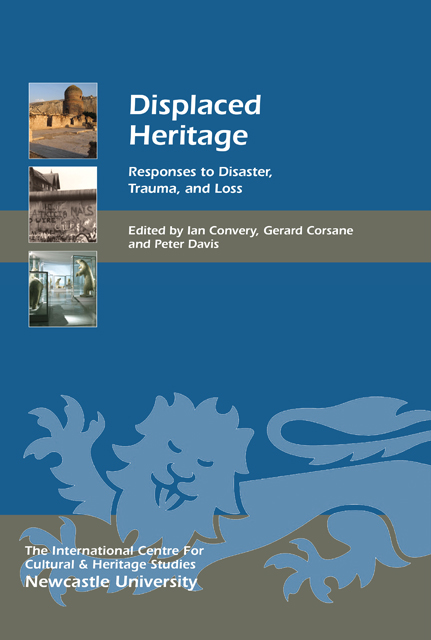Book contents
- Frontmatter
- Contents
- List of Illustrations
- Acknowledgments
- List of Abbreviations
- Preface
- Introduction
- Displaced Heritage: Histories and Tourism
- Displaced Heritage: Trauma, Confinement and Loss
- Displaced Heritage: Lived Realities, Local Experiences
- Displaced Natural Heritage
- Endpiece
- List of Contributors
- Index
- Heritage Matters
2 - Anthropogenic Disaster and Sense of Place: Battlefi eld Sites as Tourist Attractions
Published online by Cambridge University Press: 24 February 2023
- Frontmatter
- Contents
- List of Illustrations
- Acknowledgments
- List of Abbreviations
- Preface
- Introduction
- Displaced Heritage: Histories and Tourism
- Displaced Heritage: Trauma, Confinement and Loss
- Displaced Heritage: Lived Realities, Local Experiences
- Displaced Natural Heritage
- Endpiece
- List of Contributors
- Index
- Heritage Matters
Summary
Disasters are commonly associated with large-scale catastrophic events causing material destruction, economic and social hardship, loss of life and suffering. They are often unanticipated and unpredictable with consequences that last long after the immediate crisis itself. In popular understanding they are normally seen as the result of natural phenomena on a large, newsworthy scale. But disasters can also be man-made, as successive oil spills, nuclear incidents, industrial accidents, explosions and insidious environmental degradation attest. Although definitions of disaster tend to support a sense of accidental causation, war and deliberate acts of terrorism can also be included in this anthropogenic category. War is certainly a disaster for those caught up in it, both for combatants and non-combatants alike, and is often accompanied by the attendant suffering of famine, epidemics, homelessness and population displacement, both within and outside of theatres of conflict. Moreover the emotional and mental suffering of war is totally incalculable. The destruction of war is arguably more catastrophic than most natural disasters: World War II resulted in the deaths of between 60 and 78 million people, whereas the most deadly recorded natural disaster, the Bengal Famine of 1770, killed 10 million (Bowen 2012).
The destructive effects of war, however, spread much further than human suffering: the damage and depletion of a nation’s buildings; the displacement of populations with their inherent languages, traditions, music and cultural practices; and the damage and dispersion of a nation’s art treasures are just some of the examples of how both tangible and intangible heritage can become displaced and distorted by human disaster. This chapter will give examples of this process from a spatial perspective and show how, while heritage can suffer from displacement, there is much refashioning of heritage after warfare. This can be seen in a new interpretation of place and as ‘(re)-placed heritage’.
Both natural and anthropogenic disasters lead to a loss of national and personal location and place. War destroys cultural heritage either accidentally or deliberately as a ‘tactical tool’ (as, for example, Adolf Hitler’s Baedeker Raids to target the built heritage of British cities in 1942). But, like the phoenix rising from the ashes, an unintended consequence of destruction is the added poignancy and cultural resonance attached to places affected by war in the public consciousness. Sites of destruction can act as foci for national resolve after the event and become important cultural touchstones.
- Type
- Chapter
- Information
- Displaced HeritageResponses to Disaster, Trauma, and Loss, pp. 19 - 28Publisher: Boydell & BrewerPrint publication year: 2014

